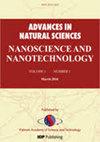A review on the types of nanomaterials and methodologies used for the development of biosensors
IF 2.1
Q3 MATERIALS SCIENCE, MULTIDISCIPLINARY
Advances in Natural Sciences: Nanoscience and Nanotechnology
Pub Date : 2024-02-02
DOI:10.1088/2043-6262/ad21e8
引用次数: 0
Abstract
Biosensors have gained significant attention in various fields such as food processing, agriculture, environmental monitoring, and healthcare. With the continuous advancements in research and technology, a wide variety of biosensors are being developed to cater to diverse applications. However, the effective development of nanobiosensors, particularly the synthesis of nanomaterials, remains a crucial step. Many nanobiosensors face challenges related to instability and selectivity, making it difficult to achieve proper packaging. While some biosensors have been successfully implemented in commercial settings, there is a pressing need to address their limitations and advance their capabilities. The next generation of biosensors, based on nanomaterials, holds promise in overcoming these challenges and enhancing the overall performance of biosensor devices. The commercial viability of these biosensors will rely on their accuracy, reliability, and cost-effectiveness. This review paper provides an overview of various types of nanomaterials and their applications in the development of nanobiosensors. The paper highlights a comparison of different nanomaterial-based biosensors, discussing their advantages, limitations, and performance characteristics.纳米材料类型及生物传感器开发方法综述
生物传感器在食品加工、农业、环境监测和医疗保健等各个领域都获得了极大的关注。随着研究和技术的不断进步,各种生物传感器正被开发出来,以满足不同的应用需求。然而,纳米生物传感器的有效开发,尤其是纳米材料的合成,仍然是至关重要的一步。许多纳米生物传感器面临着与不稳定性和选择性有关的挑战,因此很难实现适当的封装。虽然一些生物传感器已成功应用于商业环境,但仍迫切需要解决其局限性并提高其能力。基于纳米材料的下一代生物传感器有望克服这些挑战,并提高生物传感器设备的整体性能。这些生物传感器的商业可行性将取决于其准确性、可靠性和成本效益。本综述概述了各种类型的纳米材料及其在纳米生物传感器开发中的应用。本文重点比较了不同的纳米材料生物传感器,讨论了它们的优势、局限性和性能特点。
本文章由计算机程序翻译,如有差异,请以英文原文为准。
求助全文
约1分钟内获得全文
求助全文
来源期刊

Advances in Natural Sciences: Nanoscience and Nanotechnology
NANOSCIENCE & NANOTECHNOLOGYMATERIALS SCIE-MATERIALS SCIENCE, MULTIDISCIPLINARY
自引率
4.80%
发文量
0
 求助内容:
求助内容: 应助结果提醒方式:
应助结果提醒方式:


